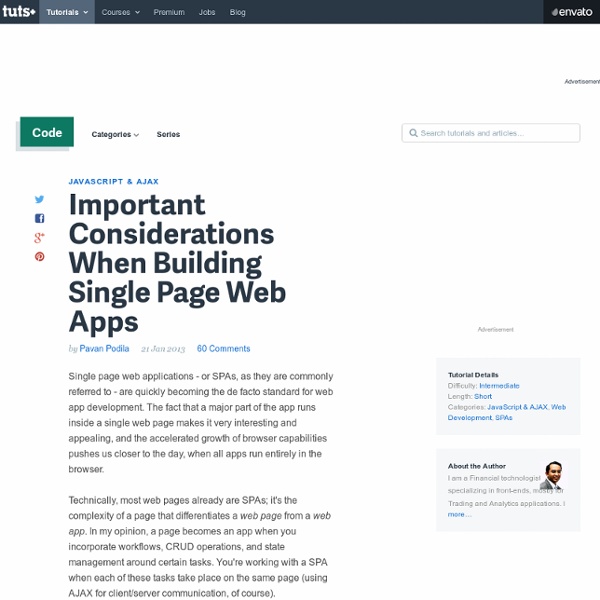JavaScript’s Strict Mode and Why You Should Use It
Starting with ECMAScript 5, developers are able to place their code into a more constrained form of execution known as strict mode. Strict mode improves JavaScript code by enforcing better programming practices and eliminating some of the language’s insecure and ill-advised features. Strict mode is enabled by adding the following directive to your code: "use strict"; The “use strict”; directive can be used in two ways.
1.3.16 demo - jQuery
Window 1 I am plumbed with a Bezier connector to Window 2 and a label, with Blank endpoints. Window 2 I am plumbed with a Bezier connector to Window 1, and a Bezier connector with Rectangle endpoints to Window 3 Window 3 I am plumbed with a Bezier connector and Rectangle endpoints to Window 2, and a Bezier connector with Dot endpoints and a label to Window 4.
Toward Modern Web Apps with ECMAScript 6
ECMAScript, the official name for the language we all know as JavaScript, has enjoyed tremendous success over the last couple of years. With convergent standard support, performance boosts from modern JavaScript engines, as well as its foray into the server-side stack, ECMAScript has gained significant traction and redefined the scope of HTML5 applications. The final requirement for world domination is the modernization of its syntax and run-time, which is coming in ECMAScript 6 and is the subject of this post. To understand the language progress within ECMAScript 6, first we need to understand how it is developed.
Learning JavaScript Design Patterns
Design patterns are reusable solutions to commonly occurring problems in software design. They are both exciting and a fascinating topic to explore in any programming language. One reason for this is that they help us build upon the combined experience of many developers that came before us and ensure we structure our code in an optimized way, meeting the needs of problems we're attempting to solve. Design patterns also provide us a common vocabulary to describe solutions.
Required JavaScript Reading
I'm asked regularly about books and online resources to get up to speed on JavaScript. Seems like everyone wants to get in on the JS action and with good reason; it's a great language to know if you're interested in exciting career opportunities. It's also pretty fun to play with. With JavaScript's increased popularity, the number of books, blogs and tutorials about the language have grown exponentially and while I can't possibly know all of them, I've found some gems which I really like and would like to share those with you. Books Note that I'm only listing books that I've read and can recommend.
api - Should I use OpenLayers or Leaflet
I have used both OpenLayers and Leaflet in my apps. There has been so much discussion on this topic in this forum and others on planet-internet. They usually fall into 2 camps - features and flexibility of OpenLayers versus simplicity of Leaflet. I would not be surprised if someone spawns an "OpenLeaf" initiative soon marrying the best of both worlds! I found Leaflet very simple to use, a petite 64K size, compared to over 700K Openlayers, and in very few steps you can create apps that have the freshness and eye-candy of today's web and mobile GIS apps.
Building Apps With the Yeoman Workflow
Trick question. It's not a thing. It's this guy:
An Introduction to Source Maps
In today's modern workflow, the code that we author in our development environments is considerably different from the production code, after running it through compilation, minification, concatenation, or various other optimization processes. This is where source maps come into play, by pointing out the exact mapping in our production code to the original authored code. In this introductory tutorial, we'll take a simple project, and run it through various JavaScript compilers for the purposes of playing with source maps in the browser. What are Source Maps? Source maps offer a language-agnostic way of mapping production code to the original code that was authored.
Resources to Get You Up to Speed in Ember.js
You've probably noticed a lot of chatter lately about the Ember.js framework and rightfully so. It aims to make it substantially easier to build single-page web apps by abstracting a lot of the complexities for writing scalable and maintainable MVC-based code. And developers are jumping on-board in droves.
Dopeless Rotate - Jquery Plugin for 360 degrees product view
24.07.2013 - Update to version 1.2.5 Hotspot links are added 28.05.2013 - Update to version 1.2.4
TodoMVC
Adequately Good - JavaScript Module Pattern: In-Depth - by Ben Cherry
The module pattern is a common JavaScript coding pattern. It's generally well understood, but there are a number of advanced uses that have not gotten a lot of attention. In this article, I'll review the basics and cover some truly remarkable advanced topics, including one which I think is original. The Basics We'll start out with a simple overview of the module pattern, which has been well-known since Eric Miraglia (of YUI) first blogged about it three years ago. If you're already familiar with the module pattern, feel free to skip ahead to "Advanced Patterns".



